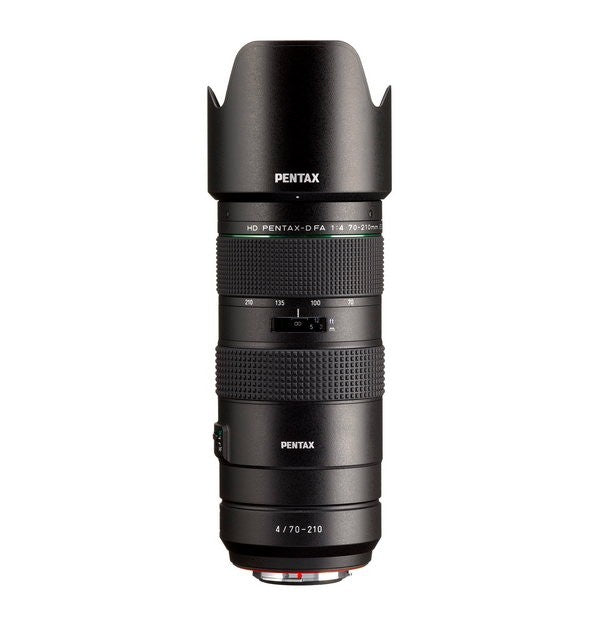Product Description
Pentax D FA 70-210mm F4 ED SDM WR HD Lens
- Quick-shift Focus System, to provide instant shift to manual-focus operation, after locking the subject in focus during AF operation by pressing the shutter-release button halfway down
- Two-step focus range limiter, to minimise AF operation time
- Nine-blade, round-shaped diaphragm, to produce a natural, beautiful bokeh (defocus) effect, while minimising the streaking effect of point light sources
- Electromagnetic diaphragm control, to provide high-precision exposure control during video shooting
- Available when mounted on a PENTAX K-1 Mark II, K-1, K-3 II, K-3, KP, K-70, K-50, K-S2 or K-S2 camera body
- Filter Diameter 67mm
- Weight approx 819g

Compact, lightweight telephoto zoom lens with outstanding portability Despite its compact, lightweight design weighing approximately 819 grams, this zoom lens covers the image circle of 35mm full-frame digital SLRs and provides a focal length range of 70mm to 210mm to facilitate handheld outdoor photography. When mounted on an APS-C-format camera, its focal length range is extended to the equivalent of 107mm to 322mm in the 35mm format.

Coupled with its compact, lightweight body, it can be easily integrated into any APS-C-format camera system. In its 20-element, 14-group optics, it incorporates three ED (Extra-low Dispersion) glass elements and two anomalous dispersion glass elements to deliver high-contrast, high-resolution images with edge-to-edge sharpness, while effectively compensating for distortion and chromatic and coma aberrations.
In addition to a short minimum focusing distance of 0.95 meters, the lens barrel was designed to be extension-free during AF operation to keep the overall dimensions intact. This allows the photographer to enjoy active field photography in a wide range of outdoor applications, including scenic photography, townscape shooting utilising a beautiful bokeh (defocus) effect in the fore- and background, close-up photography of animals and plants, and sports and wildlife photography where its outstanding portability comes in handy.

HD Coating to enhance imaging power This lens features PENTAX’s latest HD Coating.* Compared to conventional multi-layer coatings, this high-grade, multi-layer coating not only improves light transmittance but also reduces average reflectance in the visible light range by more than 50 percent, minimising the adverse effects of flare and ghost images even in demanding lighting conditions such as backlighting.
* HD is an abbreviation of High Definition.
Weather-resistant construction, perfect for outdoor photography This zoom lens features weather-resistant construction to prevent the intrusion of water into the lens barrel. When mounted on a PENTAX weather-resistant digital SLR camera body, it assures a durable, reliable digital imaging system that performs superbly in demanding shooting settings — even in rain or mist, or at locations prone to water splashes or sprays.
SP Coating to repel stains This lens features SP (Super Protect) Coating on its front surface. Applied by means of a PENTAX-exclusive fluorine deposition process, this coating is highly repellent to water, grease and dirt, making it easy to wipe off stains such as fingerprints. This frees the photographer from worries in outdoor photography.

Built-in SDM This lens incorporates a ring-type SDM (Supersonic Direct-drive Motor) to assure quiet, high-speed AF operation and improve operability in outdoor shooting.






























